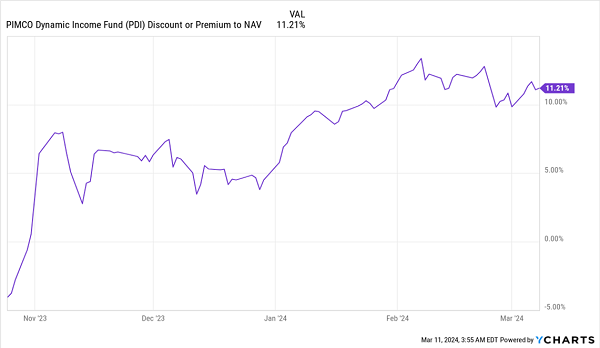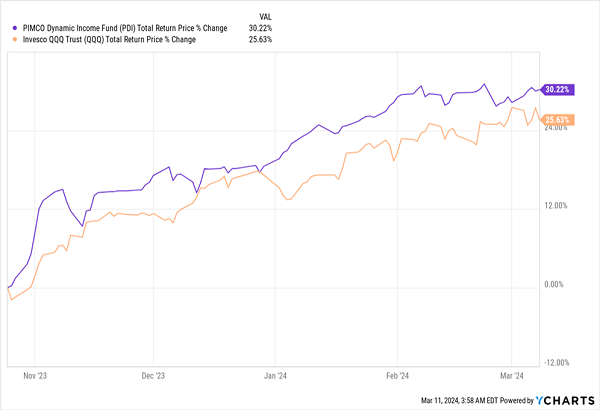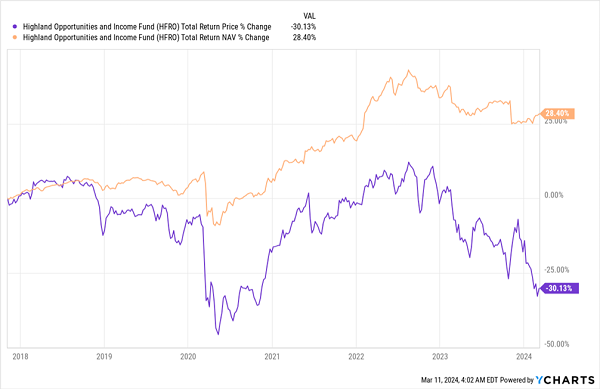Closed-end funds (CEFs) are incredible wealth generators, combining huge (8%+, in many cases) dividends, with the potential for stock-like price gains.
But to make the most of them, you need to look at one essential indicator: the discount to net asset value (NAV, or the value of the fund’s underlying portfolio).
We don’t have to go too far into the weeds here: it’s just another way of saying that CEFs can, and often do, trade for less than their portfolios are actually worth.
That makes our approach straightforward: Buy when a CEF trades at an unusually deep discount—then ride along as that discount dissipates, driving the price higher as it does. Then you simply sell at a profit. And you’re collecting those huge payouts the whole time.
We’ll dive into three of the deepest-discounted CEFs on the market (with markdowns up to 50%) in just a moment. But first, just to demonstrate how powerful a closing CEF discount can be, consider the story of a corporate-bond fund that did something few people think is possible: beat the tech-heavy NASDAQ.
How a “Sleepy” Bond Fund Crushed the Biggest Names in Tech
The PIMCO Dynamic Income Fund (PDI) yields 13.9% (you read that right) as I write this and yielded even more—an incredible 17%—in late October, when it was absurdly oversold.
Back then PDI’s discount fell to about 4%: not very generous in the world of CEFs, where discounts sometimes hit double digits, but very unusual for a fund from PIMCO, a coveted name in the investment world.
As you can probably guess, PDI’s discount didn’t stay that low for long, vanishing within days. The fund now trades at a double-digit premium.
PDI Swings From Oversold to Overbought …

The discount’s quick conversion into a premium catapulted PDI’s market-price-based return past even that of the NASDAQ—even with the big boost AI has given the index.
… And Rips Past the High-Flying NASDAQ

Can we replicate this unusual income-and-growth story in today’s market?
Absolutely, especially since the average CEF discount is currently 8.1%, which is a bit high. (Depending on how you measure, the typical long-term discount is more like 6%.)
Plus, high interest rates made it easier for funds like PDI to fund their payouts, with many corporate-bond funds paying 7%+ on average.
Which brings us to today. With PDI’s discount-driven upside now played out, what other funds are likely to see a reversal?
The first place to look is at the most discounted CEFs out there, as these are likeliest to see a short-term bump when markets realize their mistake. Three of the most discounted CEFs available now show how important this kind of analysis can be.
Deep-Discounted CEF #1: The Highland Opportunities and Income Fund (HFRO)
Let’s start with 7.2%-yielding HFRO, which is particularly interesting given that its market-price-based return has blown past its NAV return, or the gains and dividends generated by its portfolio, in recent years. That led to the largest discount on the market: a whopping 50%.
HFRO’s Market Price and Portfolio Performance Head Different Ways

The reasons for this boil down to concerns about the portfolio’s quality and management. HFRO invests heavily in assets issued by Nexpoint, including in Nexpoint Real Estate Finance (NREF), which is in the same family as HFRO’s management firm, NexPoint Asset Management. That’s made some investors uncomfortable, prompting them to look to other options.
That being said, how big can a discount get? Fifty-percent writedowns when the fund’s assets are recovering strongly from both the pandemic and 2022 meltdown suggest that HFRO could be way oversold, despite the lack of diversification in its portfolio.
Deep-Discounted CEF #2: SRH Total Return Fund (STEW)
STEW, the second-most discounted CEF we’ll look at today, is in a much different place than HFRO: it has a well-diversified portfolio spread across high-value assets.
Its holdings include the largest and most successful bank on Wall Street, JPMorgan Chase & Co. (JPM), as well as tech winners like Microsoft (MSFT) and Cisco (CSCO). Portfolio quality is not an issue here!
STEW’s portfolio is so good, in fact, we could argue that it isn’t aggressive enough, which may explain why the fund’s discount is so huge: 21.7%. Its cautious approach to stock picking means it’s more like a replacement for the Dow Jones Industrial Average, an index that focuses on value over growth.
Since growth has been in vogue for about 15 years, STEW may seem less impressive in comparison. Nonetheless, STEW has given investors an 11.5% annualized return over the last five years.
There’s another, much bigger, reason why STEW’s discount may be so big: Its dividend is tiny, at 3.7%, less than half the average CEF yield of 8.2%. That’s why STEW can’t attract enough attention to lower its discount. But if it hikes its payout, that may change.
Deep-Discounted CEF #3: Central Securities Corporation (CET)
Finally, let’s look at a fund that’s booked a triple-digit return over the last decade—and that includes the meltdowns of 2020 and 2022: Central Securities Corporation (CET). This one has survived it all and pays an 8.4% income stream to boot.
CET Is an Overlooked Long-Term Wealth Generator

CET, with a 20% discount, boasts a compelling portfolio with value darlings sporting strong cash flows, like insurer Progressive Corporation (PGR); growth plays with incredible track records, like Analog Devices (ADI); and companies with tremendous growth and strong cash flow, like Alphabet (GOOGL) and American Express (AXP).
Plus, as you can likely tell from the tickers I’ve mentioned here, the fund has diversified broadly across all sectors while choosing the best names in those sectors.
So why is CET so discounted? Because it has an unusual schedule of issuing one big dividend at the end of the year and one small one in the middle of the year, with the goal of paying out all income and gains on its portfolio as dividends.
The fund has done this for over two decades, and it’s not going to stop anytime soon! Investors who look for monthly or quarterly dividends overlook this because they can’t wait a few extra months to get paid.
And in doing so, they’re leaving money on the table. Savvier investors are likely to realize this, driving CET’s discount higher. And until they do, buying today means getting in with that very sustainable 8%+ distribution.
4 “Urgent Buy” CEFs With Huge 10.2% Dividends, 20% Gains Ahead
As we just discussed, a big part of successful CEF-picking involves looking out for a big discount to NAV. But the discount story doesn’t end there, because some funds’ discounts simply never narrow.
To pull off PDI-like gains, then, we need to make sure management has a plan to cut its discount. And 4 of my top CEFs to buy now do just that.
First up, they boast a larger average yield than these three—10.2% as I write this—and their discounts are so deep I’m calling for 20%+ price GAINS in the next 12 months..
I’ve separated them out into a FREE Special Report I’m urging ALL dividend investors to download now. Because time really is of the essence here: once interest rates roll over—a moment even Jay Powell says is close—these funds’ discounts will collapse. And their prices will soar!
Click here and I’ll tell you more about CEF discounts to NAV and give you the opportunity to download that FREE Special Report, with the names and tickers of these 4 deep-discounted, 10.2% paying funds.
Before you make your next trade, you'll want to hear this.
MarketBeat keeps track of Wall Street's top-rated and best performing research analysts and the stocks they recommend to their clients on a daily basis.
Our team has identified the five stocks that top analysts are quietly whispering to their clients to buy now before the broader market catches on... and none of the big name stocks were on the list.
They believe these five stocks are the five best companies for investors to buy now...
See The Five Stocks Here
Wondering when you'll finally be able to invest in SpaceX, Starlink, or X.AI? Enter your email address to learn when Elon Musk will let these companies finally IPO.
Get This Free Report